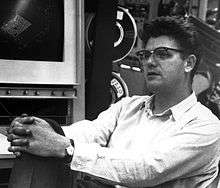Richard E. Taylor
| Richard Taylor | |
|---|---|
 | |
| Born |
Richard Edward Taylor November 2, 1929 Medicine Hat, Alberta |
| Nationality | Canadian |
| Fields | Particle physics |
| Institutions | |
| Alma mater | |
| Thesis | Positive pion production by polarized bremsstrahlung (1962) |
| Doctoral advisor | Robert F. Mozley |
| Notable awards |
|
|
Website physics | |
Richard Edward Taylor, CC FRS FRSC (born November 2, 1929) is a Nobel Prize–winning professor emeritus at Stanford University.[2] In 1990, he shared the Nobel Prize in Physics with Jerome Friedman and Henry Kendall "for their pioneering investigations concerning deep inelastic scattering of electrons on protons and bound neutrons, which have been of essential importance for the development of the quark model in particle physics."[3][4][5][6][7]
Education
Born in Medicine Hat, Alberta, Taylor studied for his BSc (1950) and MSc (1952) degrees at the University of Alberta in Edmonton, Canada. Newly married, he applied to work for a PhD degree at Stanford University, where he joined the High Energy Physics Laboratory. His PhD thesis was on an experiment using polarized gamma rays to study pion production.[8]
Research and career
After 3 years at the École Normale Supérieure in Paris and a year at the Lawrence Berkeley Laboratory in California, Taylor returned to Stanford. Construction of the Stanford Linear Accelerator Center (now the SLAC National Accelerator Laboratory) was beginning. In collaboration with researchers from the California Institute of Technology and the Massachusetts Institute of Technology, Taylor worked on the design and construction of the equipment, and was involved in many of the experiments.
The experiments run at SLAC in the late 1960s and early 1970s involved scattering high-energy beams of electrons from protons and deuterons and heavier nuclei.[9][10][11] At lower energies, it had already been found that the electrons would only be scattered through low angles, consistent with the idea that the nucleons had no internal structure. However, the SLAC-MIT experiments showed that higher energy electrons could be scattered through much higher angles, with the loss of some energy. These deep inelastic scattering results provided the first experimental evidence that the protons and neutrons were made up of point-like particles, later identified to be the up and down quarks that had previously been proposed on theoretical grounds. The experiments also provided the first evidence for the existence of gluons. Taylor, Friedman and Kendall were jointly awarded the Nobel Prize in 1990 for this work.[12]
Awards and honors
Taylor has received numerous awards and honours including
- Alexander von Humboldt Senior Scientist Award, 1982.[13]
- W.K.H. Panofsky Prize, 1989.
- Nobel Prize in Physics, 1990.
- Fellow, Guggenheim Foundation, 1971 - 1972.
- Fellow, American Physical Society.
- Fellow, American Association for the Advancement of Science.
- Elected a Fellow of the Royal Society (FRS) in 1997[1]
- Fellow, Royal Society of Canada.
- Member, American Academy of Arts and Sciences.
- Member, Canadian Association of Physicists.
- Foreign Associate, National Academy of Science.
- Companion of the Order of Canada, 2005.
References
- 1 2 "Professor Richard Taylor FRS". London: Royal Society. Archived from the original on 2015-10-21.
- ↑ Nobel autobiography
- ↑ Nobel prize citation
- ↑ Taylor, R. E. "Nucleon Form Factors above 6 GeV", Stanford Linear Accelerator Center (SLAC), United States Department of Energy (through predecessor agency the Atomic Energy Commission), (Sept. 1967).
- ↑ Taylor, R. E. "The Discovery of the Point Like Structure of Matter", Stanford Linear Accelerator Center (SLAC), United States Department of Energy--Office of Energy Research, (Sept. 2000).
- ↑ Biography and Bibliographic Resources, from the Office of Scientific and Technical Information, United States Department of Energy
- ↑ Taylors Nobel banquet speech
- ↑ Taylor, Richard Edward (1962). Positive pion production by polarized bremsstrahlung (PhD thesis). Stanford University. OCLC 38657023.
- ↑ Richard E. Taylor's publications indexed by the Scopus bibliographic database, a service provided by Elsevier. (subscription required)
- ↑ Prescott, C.Y.; Atwood, W.B.; Cottrell, R.L.A.; DeStaebler, H.; Garwin, Edward L.; Gonidec, A.; Miller, R.H.; Rochester, L.S.; Sato, T.; Sherden, D.J.; Sinclair, C.K.; Stein, S.; Taylor, R.E.; Clendenin, J.E.; Hughes, V.W.; Sasao, N.; Schüler, K.P.; Borghini, M.G.; Lübelsmeyer, K.; Jentschke, W. (1978). "Parity non-conservation in inelastic electron scattering". Physics Letters B. 77 (3): 347–352. Bibcode:1978PhLB...77..347P. doi:10.1016/0370-2693(78)90722-0. ISSN 0370-2693.
- ↑ Bloom, E. D.; Coward, D. H.; DeStaebler, H.; Drees, J.; Miller, G.; Mo, L. W.; Taylor, R. E.; Breidenbach, M.; Friedman, J. I.; Hartmann, G. C.; Kendall, H. W. (1969). "High-Energy Inelastice−pScattering at 6° and 10°". Physical Review Letters. 23 (16): 930–934. Bibcode:1969PhRvL..23..930B. doi:10.1103/PhysRevLett.23.930. ISSN 0031-9007.
- ↑ Nobel prize press release
- ↑ Taylor's entry in the SLAC index of faculty
